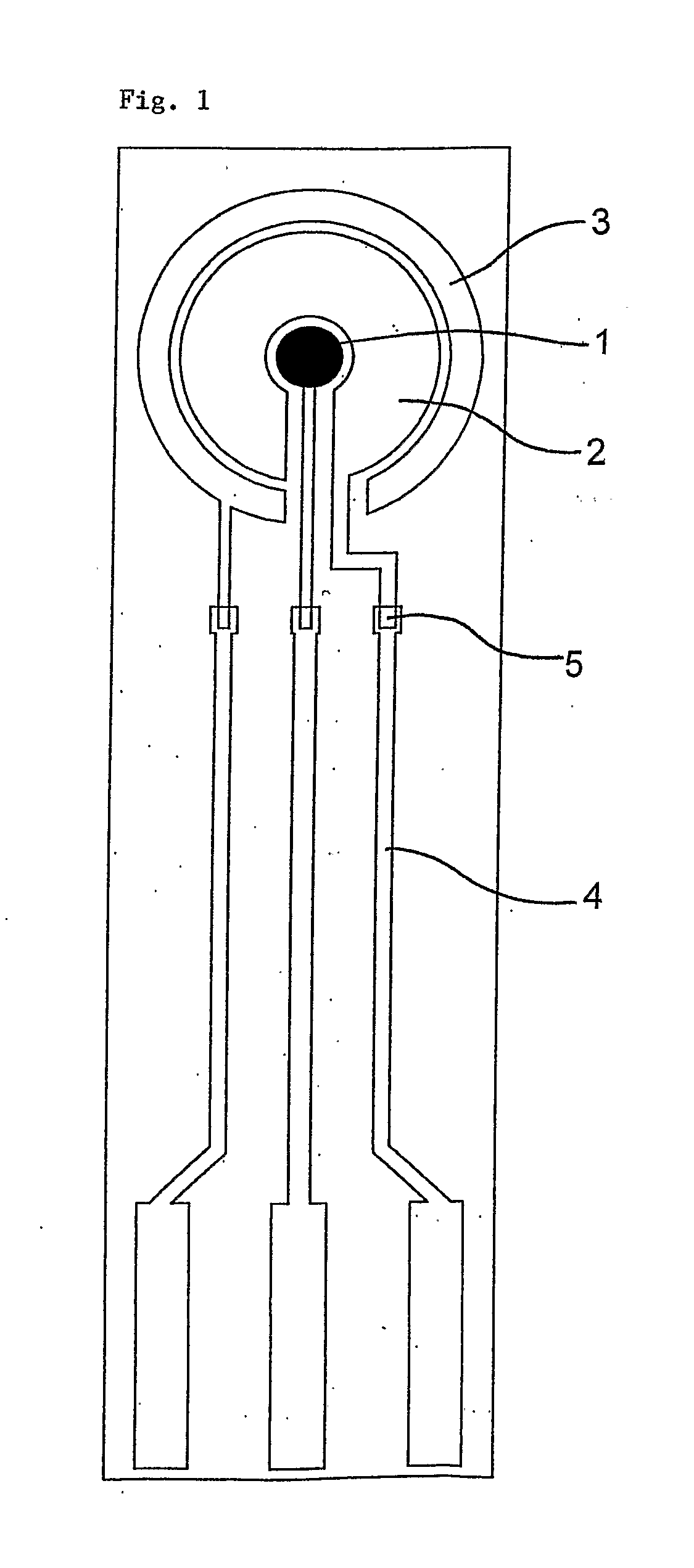Nanostructured Working Electrode of an Electrochemical Sensor, Method of Manufacturing Thereof and Sensor Containing This Working Electrode
a working electrode and nanostructure technology, applied in the field of nanostructured working electrodes of electrochemical sensors, can solve the problems of material can influence the detection properties, and disadvantageous porousness and complexity of the surface structure of the printed layer
- Summary
- Abstract
- Description
- Claims
- Application Information
AI Technical Summary
Benefits of technology
Problems solved by technology
Method used
Image
Examples
example 1
[0032]Conducting paths of silver are printed on a corundum pad by screen-printing, the pad is then left to rest for 15 minutes at the room temperature, dried for 15 to 20 minutes at 150±20° C. and subsequently fired at 850° C. In the next step, the working layer, i.e. the printed layer of the working electrode and the auxiliary electrode, is applied by screen-printing using an AuPd paste, then left to rest, dried and fired under the same conditions. The reference electrode is printed using Ag / AgCl. After resting, the motive is hardened at 150° C. for 15 min. A circle is cut with a punch from an Au film covered on both sides by protective films. The protective films are removed from the cut circle. Into the place of the working electrode, a polymeric paste is applied, the paste being the carrier medium for the cut circle. The circle is inserted into the place of the working electrode by a micromanipulator. The product is left to rest for 15 minutes and is dried for 15 to 20 minutes a...
example 2
[0033]Conducting paths of silver are printed on a corundum pad by screen-printing, the pad is then left to rest for 15 minutes at the room temperature, dried for 15 to 20 minutes at 150±20° C. and subsequently fired at 850° C. In the next step, the working layer, i.e. the printed layer of the electrode of the invention and the auxiliary electrode, is applied by screen-printing using an AuPd paste, then left to rest, dried and fired under the same conditions. The reference electrode is printed using Ag / AgCl. After resting, the motive is hardened at 150° C. for 15 min. A circle is cut with a punch from a bismuth (Bi) film. The Bi film is supplied on the mylar carrier film, the other side is protected against damage during the cutting process by a protective film. Into the place of the working electrode, a polymeric paste is applied, the paste being the carrier medium for the cut circle. The protective film is removed from the cut circle. The circle is inserted with the Bi side into th...
PUM
| Property | Measurement | Unit |
|---|---|---|
| Temperature | aaaaa | aaaaa |
| Thickness | aaaaa | aaaaa |
| Length | aaaaa | aaaaa |
Abstract
Description
Claims
Application Information
 Login to View More
Login to View More - R&D
- Intellectual Property
- Life Sciences
- Materials
- Tech Scout
- Unparalleled Data Quality
- Higher Quality Content
- 60% Fewer Hallucinations
Browse by: Latest US Patents, China's latest patents, Technical Efficacy Thesaurus, Application Domain, Technology Topic, Popular Technical Reports.
© 2025 PatSnap. All rights reserved.Legal|Privacy policy|Modern Slavery Act Transparency Statement|Sitemap|About US| Contact US: help@patsnap.com



